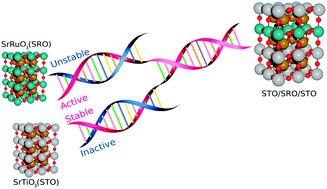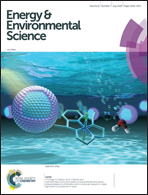Activation of ultrathin SrTiO3 with subsurface SrRuO3 for the oxygen evolution reaction†
Abstract
Water electrolysis occurs via the oxygen/hydrogen evolution reactions. Achieving sufficiently high oxygen evolution reaction (OER) activity while maintaining stability of the active catalyst surface is a primary challenge of designing OER catalysts. Often high electrocatalytic activity is accompanied by structural instability. This is the case for the metallic perovskite oxide SrRuO3 (SRO), which exhibits rapid dissolution under OER conditions, both as thin-films and as nanoparticles. On the other hand, large band-gap perovskite oxides such as SrTiO3 (STO) are inactive for OER in the dark but are stable. In this work, we demonstrate that burying as little as one unit cell of SRO beneath an ultrathin STO capping layer activates the otherwise inert electrocatalyst and gives excellent stability. Using density functional theory (DFT) calculations, we find that such a chemical modification of STO by sub-surface SRO introduces new 4d electronic states including Ru states within the STO band gap, raising the energy level of the electrons, changing the electronic hybridization, and facilitating an easy transfer to the adsorbed intermediates. We validate this hypothesis experimentally using atomically precise heteroepitaxial deposition. We find that a single-unit-cell layer of SRO is sufficient to activate the topmost STO layer towards OER; burying SRO underneath two unit cells of STO protects the inherently unstable SRO against corrosion during OER. Generally, our layered heterostructures are model systems of oxide core–shell structures, where an unstable catalyst (core) is protected against degradation and electronically activates the otherwise inactive shell. As demonstrated in this work, the growth of ultrathin heterostructures establishes a rigorous platform for screening core/shell nanoparticle combinations/thicknesses, and elucidates sub-surface activation mechanism for achieving stable and active oxide electrocatalysts.



 Please wait while we load your content...
Please wait while we load your content...
